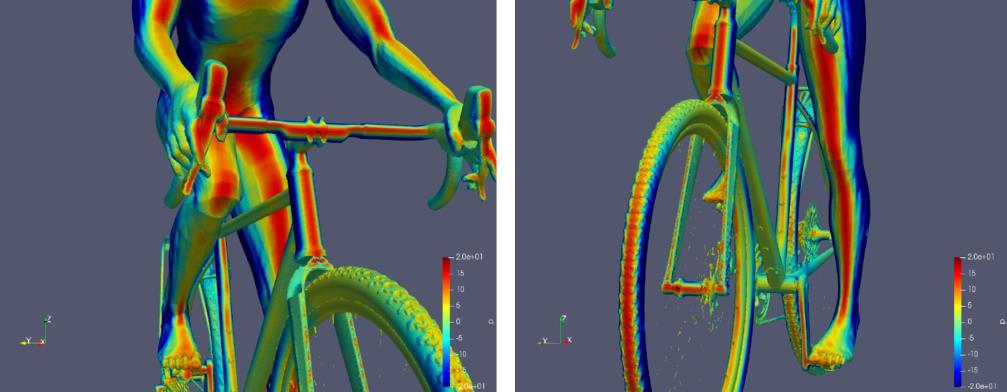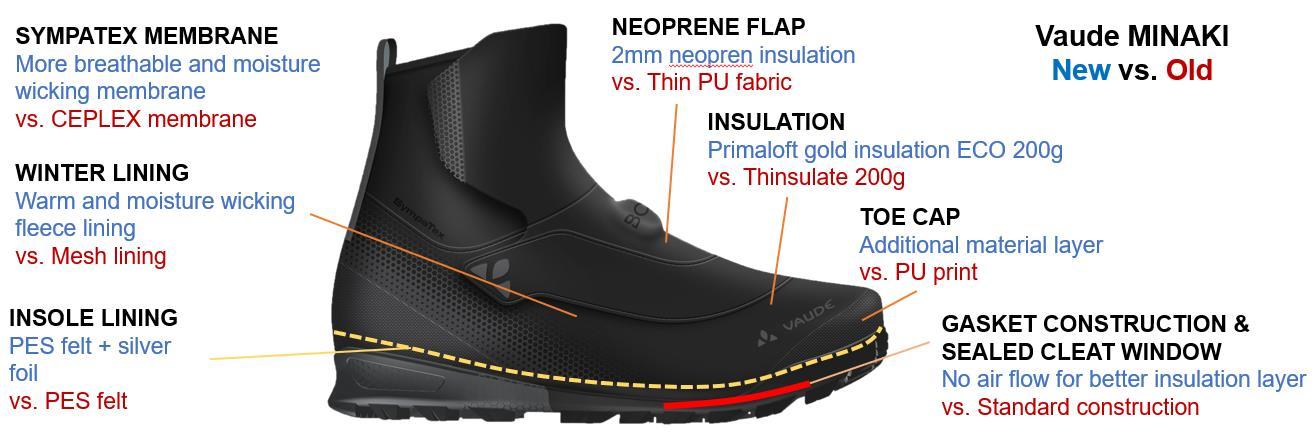Thermal Comfort of Winter Cycling Footwear
Frank I. Michel1 , Sarah Campos11, Wouter Remmerie2, Fredrik Fuhrmann1
1 VAUDE Sport GmbH &Co. KG, i-team, Germany (www.vaude.com) 2 AirShaper, Antwerp, Belgium (www.airshaper.com)
Introduction
Too cold and windy environmental conditions represent the most common reason shoe towards optimised thermal comfort – also considering the influence of for commuters not to go to work by bike (Sears et al., 2012). Footwear plays a headwind on skin foot temperature. In a first step a computational fluid dynamic key role for the overall thermal comfort in cold environment. Cold feet represent analyses (CFD) were performed to detect the influence of headwind on defined a symptom of general cold discomfort (Kuklane, 2013). If the insulation foot regions at three different pedal/foot positions. These findings should be properties of the clothing system are inadequate and athletes feel cold, they will implemented in the further development of the new shoe model. In a second step often perceive it in the feet. the newly developed winter cycling shoe should be evaluated within a subject The overall goal of the research project was to improve an existing winter cycling study by means of thermal imaging and subjective perception.
CFD Analysis
Material & Method
CFD analyses were done at AirShaperTM using a steady- state RANS (Reynols Averaged Navier Stokes) method with k-omega SST turbulence model. The boundary conditions used are: wind speed: 5.5 ms-1; air temperature: 15°C, air density: 1.225 kgm3; atmospheric pressure: 101300 Pa. The focus of this study was on the lower leg. The three analysed pedal/foot positions (Fig. 2) were derived from Broker (2003). The qualitative evaluation of the simulation was focused on the general flow patterns (3D trajectories of “air particles”) and the pressure and velocity profiles around the foot. 3D wake patterns (iso-surfaces for a total pressure equal to zero) were also considered. Local surface pressure and surface streamlines were used as the prime indicator for possible air penetration through the upper material.

Results
The CFD results show that the pedal/foot position has a substantial influence on surface pressure (Fig. 1 & 2). Especially the “heel-up”-position is strongly affected by headwind. The most important effect in that position is high surface pressure around the dorsum of the foot. Independent of the pedal/foot position the toe area especially the anterior margin of the toes and the space between the toes show a high surface pressure and subsequently a higher risk for (cold) air penetration. Moreover, a high surface pressure can be observed around the anterior aspect of the ankle joint complex (AJC). Therefore, these three locations (toe area, dorsum and anterior aspect of AJC) should offer best insulation, wind- and waterproofed characteristics.


Infrared-Study
Material & Method
Four male bike commuters (37±10 years; 176±0,1 cm; 76±11kg) participated on the subject study. They performed a load profile of 30 min. cycling on a Tacx cycling trainer at 120W. Each subject had to cycle in 2 benchmark models and in the old vs. new Vaude cycling shoe (Fig. 3).

The subjects were tested in a climate chamber at 0±1°C and ~90% relative humidity. Two floor fans were positioned in front of the cyclist generating an airflow aimed at the lower legs of the cyclist. An infrared camera (FLIR E85) was used to determine surface temperature. The barefoot IR images and subjective feedback were taken just before and after the cycling activity.
Results
The new Vaude shoe indicates the lowest temperature loss and hence the best insulation characteristics within the tested footwear conditions (Fig.4). The old Vaude model and Northwave exhibit a substantially higher temperature loss of more than 2°C. The thermal images (Fig. 5) of all 4 tested footwear conditions clearly indicate the toe area as the anatomical location with the lowest skin temperature and thus the most vulnerable region to suffer from cold thermal discomfort.


Discussion & Conclusion
There is only little research available on thermal comfort of athletic footwear in cold weather conditions. However, studies which investigated the thermal comfort of ski boots emphasise the importance of insulation properties and wind resistance (Hofer et al. 2014). In addition, Hofer et al. (2014) point out the importance of keeping the feet and particularly the toes warm during skiing. This goes hand in hand with the present CFD results and the findings based on thermal imaging. The findings of both CFD analyses and subject study clearly illustrate that the dorsum of the foot and especially the toe region is most susceptible for thermal comfort during cycling in cold weather conditions. In that context appropriate footwear should offer optimal insulation properties and protection against wind and moisture. However, not only the material and the design of the footwear but also the whole foot-sock-footwear system should be considered when optimizing the thermal foot comfort. The material and design interventions applied to the new Vaude shoe clearly confirm the opportunity to improve the thermal comfort, which was not only based on objective data but also on subjective feedback.
References
Broker JP (2003) Cycling biomechanics: Road and mountain. In ER Burke (Ed.), High-Tech cycling (pp. 119-145): Human Kinetics.
Hofer P, Hasler M, Fauland G, Bechtold T, Nachbauer W (2014) Microclimate in ski boots – Temperature, relative humidity, and water absorption. Appl. Ergon. 45(3): 515-520.
Kuklane K (2013) Footwear for cold weather conditions. In A. Luximon (Ed.), Handbook of Footwear Design and Manufacture (pp. 283-317): Woodhead Publishing.
Sears J, Flynn BS, Aultman-Hall L, Dana GS (2012) To bike or not to bike: Seasonal factors for bicycle commuting. Transp. Res. 2314(1): 105-111.
Thanks to Karsten Westphal (adidas future)
SCIENCE & CYCLING Conference, 24th –25th June 2020, Nice - France for methodical support of the IR study
Download Original Paper
